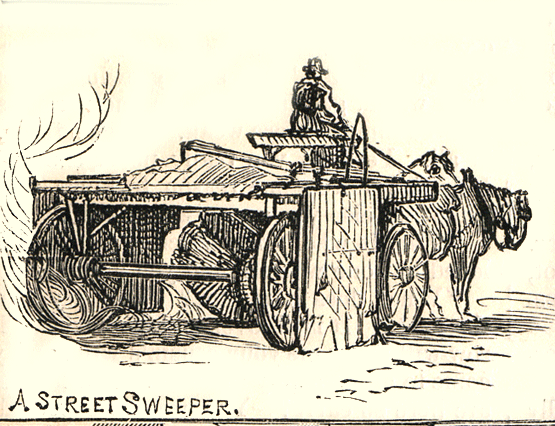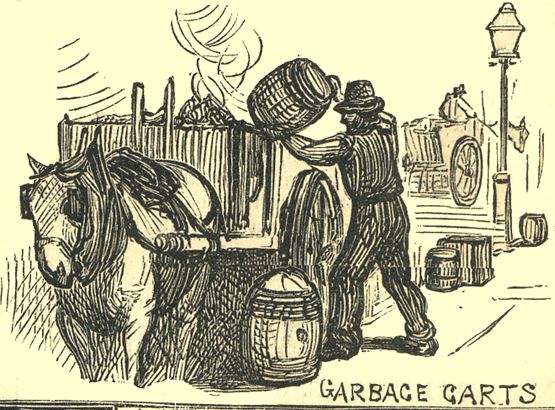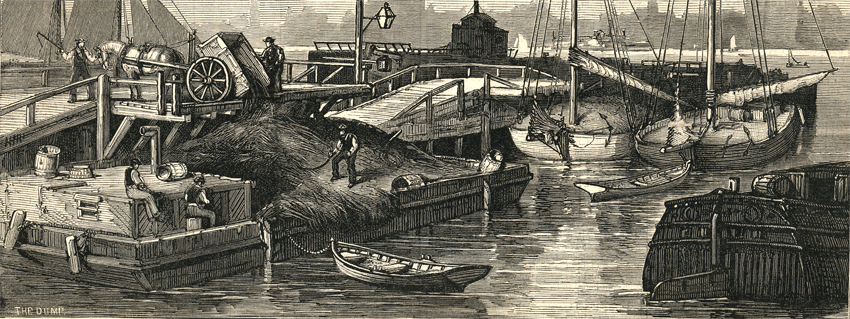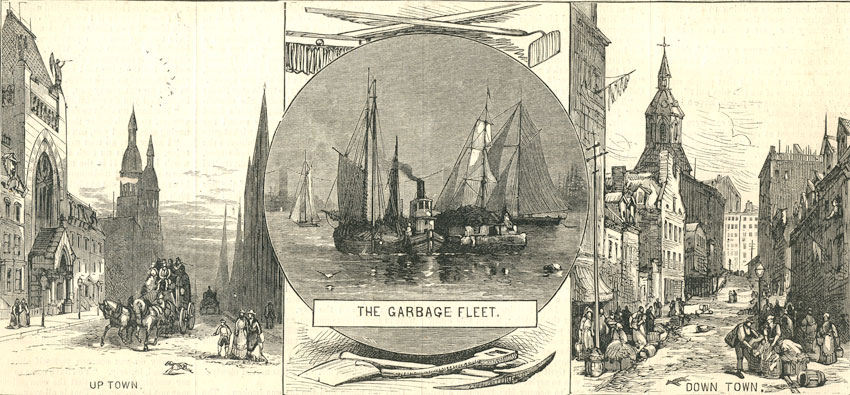The following is a verbatim transcript from the pages of the Harper's Weekly, November 24, 1877. WorldSweeper purchased a large, one-page photo montage page and the owners were good enough to find the article information to include, as well.
Have a sweeper operator who's complaining about something – anything – about his or her job? How about a customer who is complaining about debris build-up or how clean the street is after the sweeper goes by. You may want to suggest they read this article...

How the Streets of New York are Cleaned
The series of sketches will give our readers a good idea of the clumsy, expensive, and inefficient method adopted in this city for keeping the streets clean. New York is notoriously one of the least cleanliness citizen of the civilized world, although Anna Norma Psalm is expected every year for the purpose of gathering and removing ashes, garbage, and sweepings from the public thoroughfares. Nearly $1 million is paid annually for half doing a work which, if properly carried on, might be made a source of profit to the city.
 The Street Cleaning Bureau employs an army of sweepers and cart-drivers. It is the business of the first, with scrapers and stiff brooms, to collect the refuse of the streets into little heaps, in readiness for the carts, which are started out as soon as darkness sets in and streets are comparatively free from other vehicles.
The Street Cleaning Bureau employs an army of sweepers and cart-drivers. It is the business of the first, with scrapers and stiff brooms, to collect the refuse of the streets into little heaps, in readiness for the carts, which are started out as soon as darkness sets in and streets are comparatively free from other vehicles.
These carts are intended to carry away not only the sweepings of the "Broom Brigade," but also the collections of garbage, ashes, etc., placed in barrels and boxes before each house.
As soon as a cart is filled, the driver takes his way to the "dump" of the district he is at work in, and after having deposited his load, he returns for another. Owing to the neglect of proper supervision, and the carelessness of the men employed in removing house refuse, complaints are constantly made of the indifference shown by the Street-Cleaning Department in not removing the garbage, ashes, etc., placed upon the sidewalk for removal by the dwellers.
No discipline is maintained; the driver of the dirt wagon goes along removing what he pleases, and neglecting to take anything that does not suit him. It is also a regular plan for the drivers to start off for the "dumps" when they have only collected half a load, and so shorten their labor for the night.
 Repeated complaints have also been made as to the system of extortion put in practice by the drivers of the collection carts. "No pay, no removal," seems to be a favorite rule with them. This is particularly the case with hotels, dining-rooms, oyster-houses, and suchlike establishments where generally a considerable amount of refuse accumulates daily.
Repeated complaints have also been made as to the system of extortion put in practice by the drivers of the collection carts. "No pay, no removal," seems to be a favorite rule with them. This is particularly the case with hotels, dining-rooms, oyster-houses, and suchlike establishments where generally a considerable amount of refuse accumulates daily.
As a rule, from $.25-$.50 per day is the amount paid to an accommodating driver. The uptown districts of the city present a marked contrast to the lower districts, where the refuse and garbage are sometimes allowed to collect for days before removal.
There are 14 public dumps or depots for the accumulation of the city's refuse. Of these, five are situated on the North River, at the following points: 46th St., 37th St., 21st St., 12th St., and Laight Street. Nine are situated on the East River, as follows: 86 Street, 46 Street, 38th St., 22nd St., 17th St., Fifth Street, Stanton St., Jackson Street, and Market Street.
At the foregoing points all the refuse collected is dumped on board scows and barges for removal. These scows and barges are large flat-bottomed boats, as shown in our engraving. When a number of them are loaded, they are towed to the various dumping grounds by steam-tugs, of which there are two constantly in the employment of the Street-cleaning Bureau.
Great difficulty has been experienced in the selection of proper dumping grounds for the immense amount of garbage and other refuse annually removed from our streets. Wherever deposited, it speedily becomes a nuisance; and, the officials in charge of the business have generally shown no regard to public or private interests in their haste to get rid of the accumulation at the least expense and trouble to themselves.

Last summer they nearly ruined navigation at the Stepping Stones in Long Island Sound, destroyed valuable oyster beds in that vicinity, and rendered the shores of Long Island almost uninhabitable, as the tide swept ashore the garbage thrown overboard from the scows.
At one time during the early part of the summer the nuisance became so great as to create a panic among residents and hotel-owners along the Long Island shore, as the many watering-places located there were being deserted, owing to the dangerous and disgusting nuisances created by the public officials in their efforts to get rid of the city's garbage and refuse.
Many other places around the city have suffered from the same cause. Harlem Flats, of which the lower cut on the page will convey a good idea, has been a favorite dumping ground, greatly to the detriment of the public health.

Repeated attempts have been made to use the bay as a dumping ground. Owing to the peculiar outline of the Long Island coast, it was impossible to deposit any refuse in the bay without a very large percentage of it being washed ashore on the Coney Island beach.
Dead animals, old beds, garbage, and everything that did not immediately sink were by the action of the tide and winds washed ashore along this line and that of Staten Island, until the nuisance became so great as to demand immediate action on the part of the property owners along the shore.
Within the past two years immense sums of money have been expended in improving Coney Island Beach, and with such success that this place has become one of the most popular summer localities within the vicinity of New York. Without warning, a new and peculiar danger threatened the entire place.
All kinds of offensive and disgusting filth was washed ashore; dead animals undergoing rapid decomposition, putrid garbage, rotting beds, etc., came gently floating on the tide, rendering it impossible to bathe in this otherwise favorable spot. The prompt and energetic action of the Brooklyn Shore Inspector soon put an end to this gross outrage.
Two plans have been proposed for the disposal of the city refuse; one is to want to burn it in immense furnaces; the other to establish large storage reservoirs, where it can be collected, submitted to the action of disinfecting agents, and allowed to remain until it has undergone the changes necessary to make it available as a fertilizer. The first plan involves waste and expense. By the second, the refuse might be made a source of profit to the city.

All of the above images were drawn by W. P. Snyder.
We're always on the lookout for sweeper-oriented information we can add to the website, so let us know if you find interesting information about sweeping.